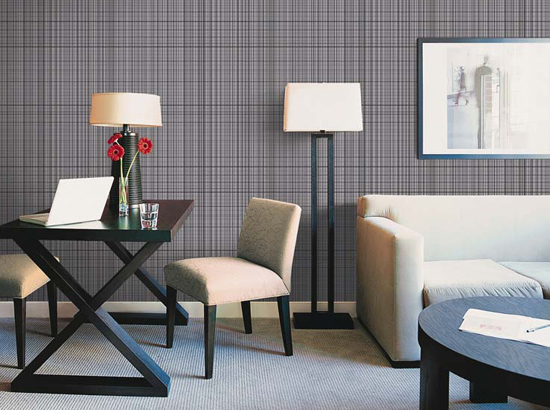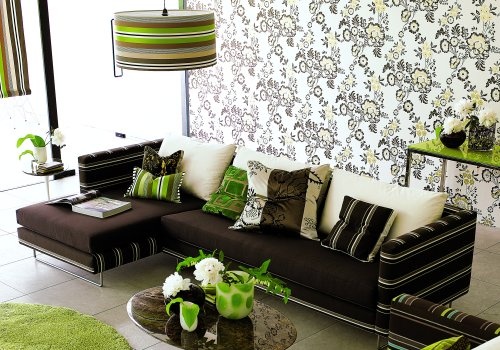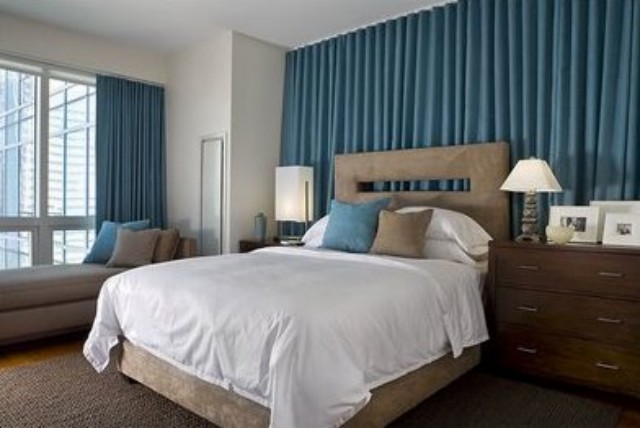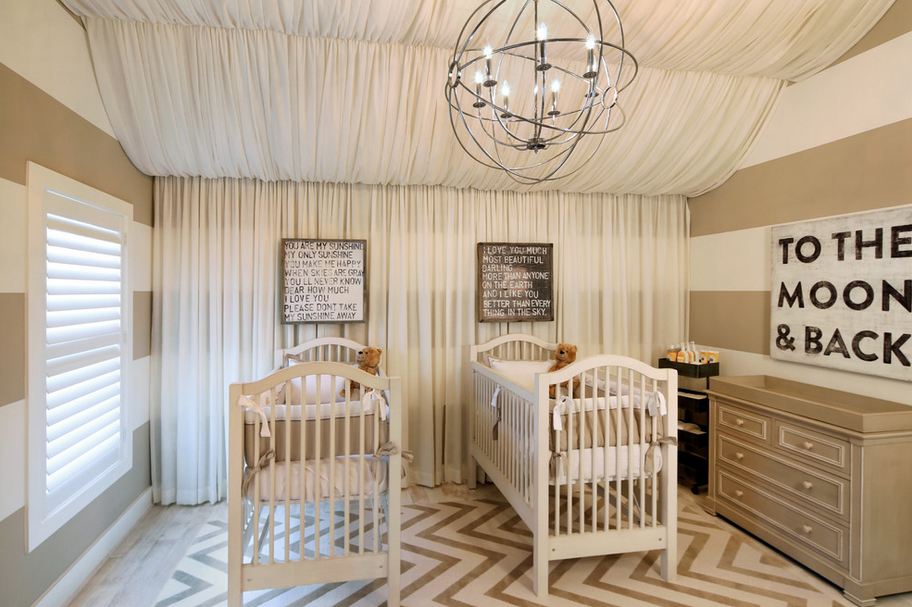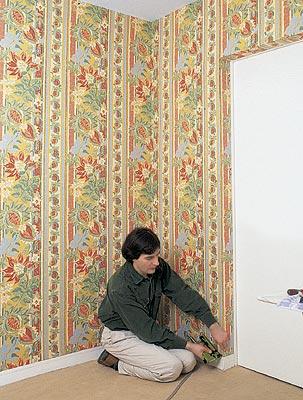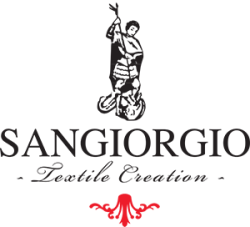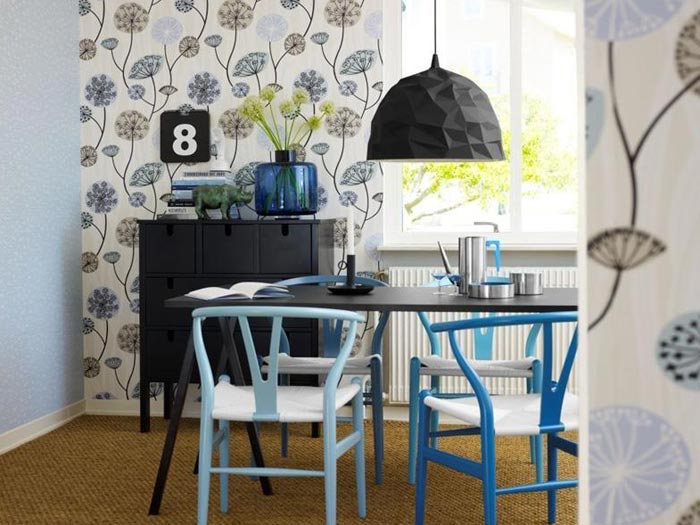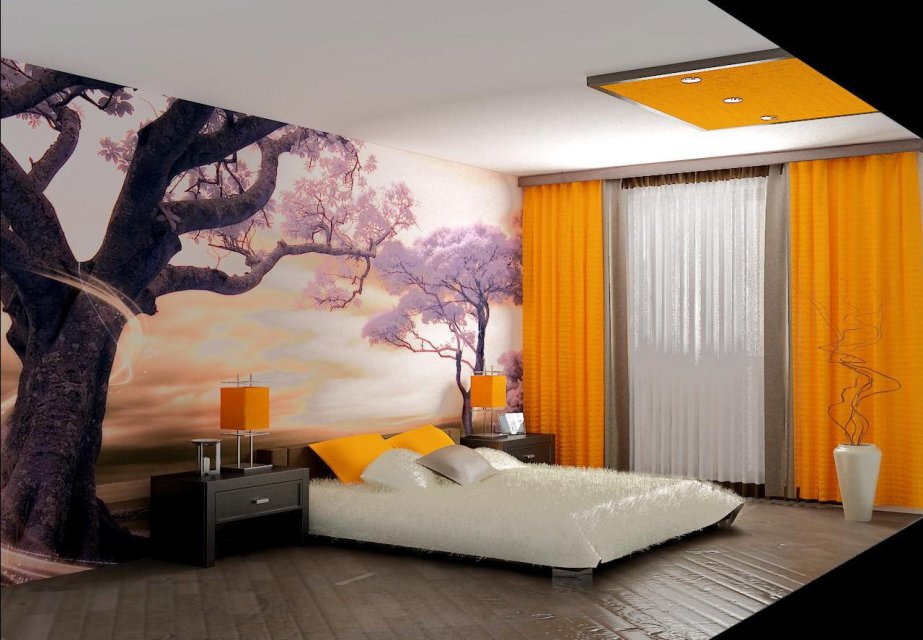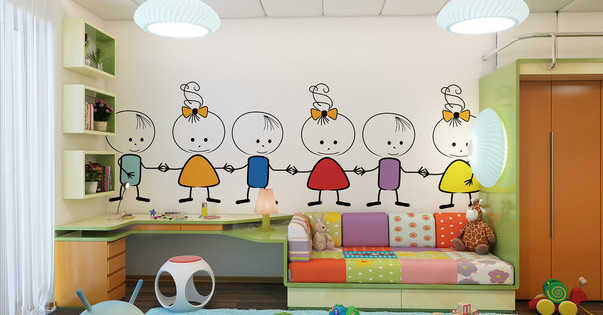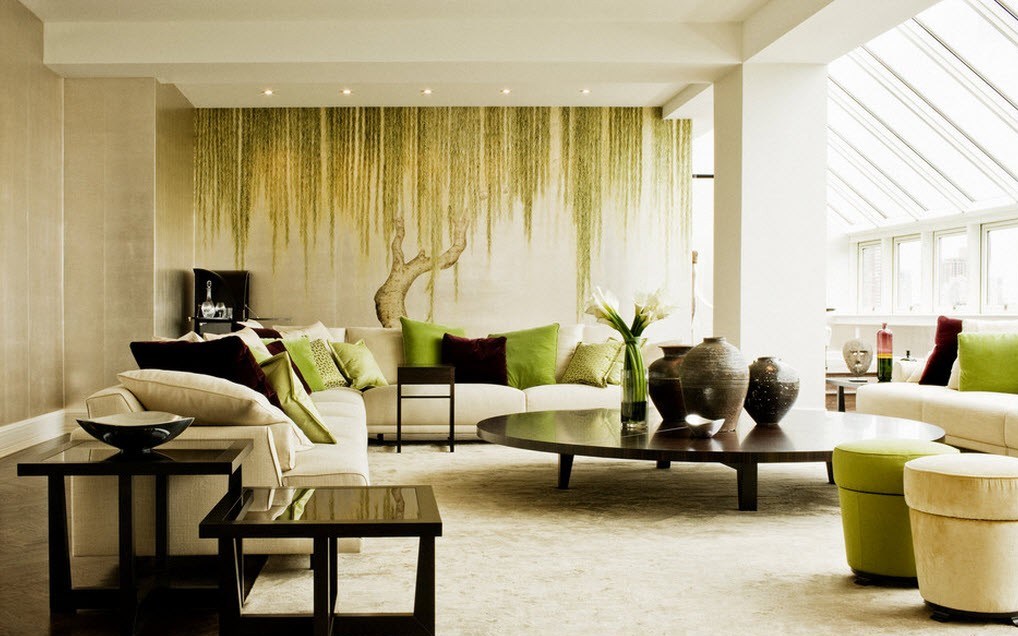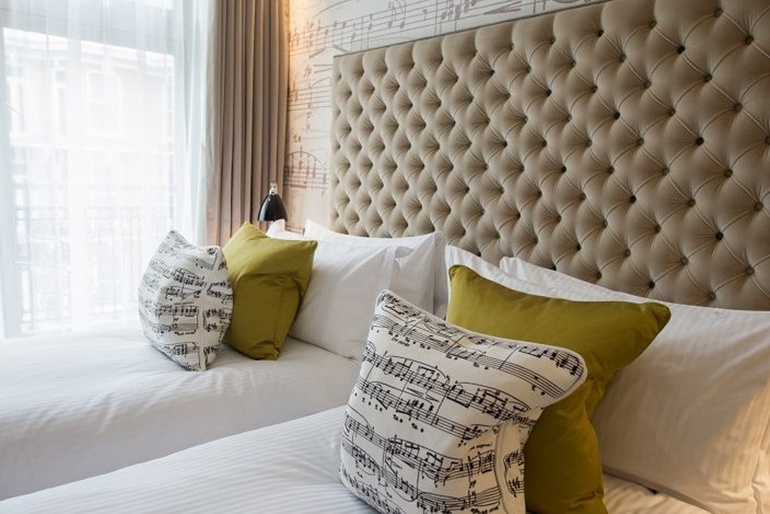8 Tips for Choosing Wall Cloths
To make the interior exclusive and unique, use a variety of wall decoration options. One of the most interesting options is wall decoration with fabric. There are various ways and options to realize its mass, since the fabric can be fixed in different ways, canvases of different colors and patterns can be used, combined with other materials, resulting in a truly original solution. What you need to consider when choosing a fabric for wall decoration and what are the ways to fix it?
No. 1. Advantages and disadvantages of wall decoration with fabric
The steadily growing popularity of wall decoration fabric is due A number of advantages of this decor:
- aesthetics and excellent appearance with a huge variety of possible colors and patterns - this is the main plus of this finish;
- extra onesbad and soundproofing premises;
- natural fabric is a breathable material, therefore it will help maintain the optimal microclimate of the room;
- this way you can mask minor wall flaws;
- the fabric is elastic, so shrinkage will be fearless;
- lack of garbage during finishing;
- if the fabric is wide, then the number of seams will be minimal.

The fabric has significant disadvantages:
- the material is able to absorb odors, so it is better to use such a finish as far as possible from the kitchen;
- the fabric attracts dust, so it will need regular care;
- independently cope with the installation of fabric is somewhat more difficult, than wallpaperalthough the process cannot be called too complicated.
Modern manufacturers offer fabrics that are processed with special compounds, so they absorb less moisture, do not fade, do not attract dust and can even withstand moisture, so The disadvantages of such a finish are gradually minimized.
No. 2. Which fabric is best for walls?
For wall decoration, you can use almost any fabric:
- natural. Often used jacquard, brocade, linen, less often use cotton, silk, satin;
- artificial. The most striking example is viscose;
- synthetic: polyester, polyamide, polypropylene.
Of course, synthetic and artificial fabrics behave much better in use, they do not crumple, do not accumulate static electricity, they do not attract dust, they almost do not fade, but they are not natural. The best option is mixed fabrics., made partially from natural fibers, partially from synthetic fibers, which allows them to perform wonderfully and remain breathable.
It is better to purchase fabric that went through special processingto be more resistant to sunlight, dust, moisture.
Drawing is better to choose such that he does not tire and irritate his sight with motleyness. Some fabrics have a foam backing, which gives them improved strength characteristics.
No. 3. Where is better to use fabric trim?
Given the properties of the fabric, calling it a universal finish for any room will not work. This material is best used in rooms such as:
- bedrooms;
- living rooms;
- classrooms.
Kitchens, hallways, children’s, - all these are rooms where walls often get dirty, and since cleaning the material is a very complex and time-consuming process, it is better to refrain from this type of decoration. However, often the fabric is used to decorate the walls in restaurants.
Number 4. Methods for attaching fabric
Today, several methods of decorating walls with fabric are used. The main ones are:
- pasting - the most common option, which is somewhat reminiscent of installation of wallpaper, so the area of the room does not decrease. In this case, it is better to use light fabrics (muslin or tulle, for example), so the surface of the walls should be aligned and smooth.

- upholstery. This method requires the construction of a frame, so the space of the room will be reduced by a few centimeters, and additional materials will be required, but the main surface can hardly be prepared for decoration, and the wires can be easily placed behind the fabric;
- drapery. In this case, the textile will resemble familiar to us the curtains, only they will not cover the window, but a blank wall or partition. Cornices can be both decorative and hidden. Sometimes, instead of hidden cornices, adhesive tape is used, which subsequently simplifies the process of washing the fabric. Thus, it is possible to carry out both light draperies and lush multi-tiered ones, and even decorate the walls according to the principle of Japanese curtains, so this decoration option is perfect for any type of interior;

- decoration of part of the wall, niche, creating applications. In this case, the fabric can be attached using one of the methods listed above, but only on part of the wall. This decoration looks spectacular over headboard the beds, especially when the same fabric is used for wall decoration, and for curtains. Thus, it is possible to zone the space of a room, to emphasize interesting elements, for example, niches.
No. 5. How to paste the walls with a cloth?
Of course, the process of mounting the fabric on the walls is not the easiest and cannot be dealt with alone, but together with the proper level of accuracy, gluing the walls with fabric is not so difficult. The main thing is to follow simple tips:
- choose the widest fabric possible, ideally, the width of the roll should be greater than the height of the room - then the finish will be completely seamless. If the width is not enough, then you need to sew several pieces of fabric in advance to get the canvas of the required size;
- important attention should be paid to the preparation of the walls: they should be smooth, even and dry;
- if the material shrinks slightly, then it is enough just to iron it, if the shrinkage is strong, then, first of all, it needs to be wet, dried and ironed, and only then proceed to stitching the paintings;
- glue the finished canvas only along the edgesglue is applied to the wall. It is easier to start from the extreme left side, the width of the glue strip is about 10 cm. If the fabric is heavy, then it is better to use an additional temporary fastening - wooden battens;
- next stick the top edge of the fabric and wait until the glue is completely dry, so that you can properly pull the fabric cloth and glue it first on the right side, and then from the bottom;
- it is better to take fabric with a margin, and after installation, the excess parts can simply be cut;
- you can start gluing on top, then fasten the fabric on the sides, and then - from the bottom.
At the edges where the fabric adhered to the wall, air bubbles may form the next day. In this case, it is enough to make punctures and iron with an iron.
After mounting and drying the fabric, the wall can be decorated skirting boards, moldings, baguettes - there is already a matter of taste and the chosen style of interior.
No. 6. How to upholstery the walls with fabric?
Upholstery or even covering the walls with fabric will require the construction of a frame that can be made of wooden, plastic or even rubber planks. Usually they use wooden planks, and the installation process looks like this:
- necessary prepare the wooden planks of the desired length, 10 mm thick and 50-70 mm wide;
- all horizontal strips are attached first: under the ceiling, above the floor, above door and window openings;
- then the vertical bars are mountedstarting from an angle in increments of 0.5-0.6 m;
- to start fixing the ironed canvas, it is necessary from the angle near the ceiling, use a stapler or nails, the distance between which should be at the level of 5-10 cm;
- the fabric is pulled with great effort, the verticality of the panel is checked with a plumb line, while making sure that wrinkles do not form on the fabric;
- fabric allowances after installation, screwdriver tucked under wooden planks.
Instead of wooden planks, you can use a ready-made PVC profile, thanks to which you can get the most bizarre shapes, however, it is quite expensive and is used to fasten polyester.
Number 7. How else can I fix the fabric to the wall?
Not so often, but still used a method of attaching fabric using nails. In this case, the matter is simply nailed to the wall - easy and reliable. On the edges you can use roofing nails, in the center - with decorative hats.
Fabric drapery performed as simple as possible. In this case, it is enough to glue the tape with loops on the wall, and sew the second part of the tape with hooks to the canvas. Thus, you can get any kind of drapery and the most interesting effects. Moreover, the fabric can be removed and washed at any minute.
Number 8. Wall Cloth Manufacturers
Of course, no one forbids using absolutely any fabric for wall decoration, but to obtain the highest quality result, it is better to use fabrics from the most famous manufacturers, among which it is worth highlighting:
 Bekert textiles Is a Belgian manufacturer of textiles. Its wall decoration fabrics require a minimum of care, are distinguished by their tight weave and the presence of a Teflon coating, which makes the surface as resistant to mechanical damage as possible. The manufacturer claims that its fabrics are resistant to high humidity and may even be used in bathrooms. The range of drawings and patterns is more than decent;
Bekert textiles Is a Belgian manufacturer of textiles. Its wall decoration fabrics require a minimum of care, are distinguished by their tight weave and the presence of a Teflon coating, which makes the surface as resistant to mechanical damage as possible. The manufacturer claims that its fabrics are resistant to high humidity and may even be used in bathrooms. The range of drawings and patterns is more than decent;- Creation baumann - Swiss-made fabrics, which are characterized by increased strength and mass of a wide variety of shades and patterns, there is even a fabric with the effect of a starry sky;
 Sangiorgio - a famous Italian company for the production of jacquard fabrics. Production has been operating for over 40 years, and all this time the traditions and principles have remained unchanged: the highest quality and constant expansion of the range. Wall fabrics are presented in several collections, so it is not so difficult to find the most suitable canvas for design;
Sangiorgio - a famous Italian company for the production of jacquard fabrics. Production has been operating for over 40 years, and all this time the traditions and principles have remained unchanged: the highest quality and constant expansion of the range. Wall fabrics are presented in several collections, so it is not so difficult to find the most suitable canvas for design;- Lesura - French-made fabrics based on cotton, polyester and foam, or cotton and viscose. Rolls have a width of 2.6-2.95 m, so in the vast majority of rooms you can mount the coating seamlessly. All assorted fabrics have anti-dust and anti-fog coating, do not fade in the sun, so the company is not afraid to give a guarantee on its products for 10 years. The assortment includes 21 textures and 170 colors;
 Clara lander - French manufacturer of fabrics, which has been on the market since 1981. Today, its products are used by designers around the world to equip residential buildings, offices, hotels, restaurants and television studios. The range of colors is impressive: from plain canvases of calm shades to fabrics that mimic the colors of animal skins. All fabrics of the company possess antistatic properties, are waterproof, they are processed by anti-mold and antibacterial compounds. Stains from the surface can be easily removed; standard and fire-retardant products are on sale. Fasten these fabrics to the wall using a frame;
Clara lander - French manufacturer of fabrics, which has been on the market since 1981. Today, its products are used by designers around the world to equip residential buildings, offices, hotels, restaurants and television studios. The range of colors is impressive: from plain canvases of calm shades to fabrics that mimic the colors of animal skins. All fabrics of the company possess antistatic properties, are waterproof, they are processed by anti-mold and antibacterial compounds. Stains from the surface can be easily removed; standard and fire-retardant products are on sale. Fasten these fabrics to the wall using a frame;- Bruvatex - a famous Belgian manufacturer of quality fabrics for wall decoration.Fabrics with a width of 2.8 m are made from cotton or from a mixture of cotton and viscose, all fabrics are treated with antistatic and anti-combustible compounds, so their service life is quite long. They are attached to the wall on the profile, in the assortment there are a lot of flowers and drawings for every taste. Stains from such a coating are easily removed - the main thing is not to leave them to dry.
If you take the fabric from a reliable and reputable manufacturer, then all the disadvantages of wall decoration with fabric can be minimized, enjoying only the many advantages.

